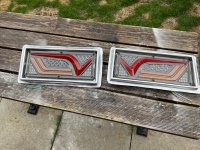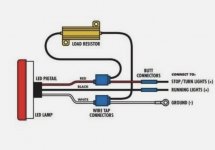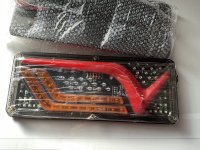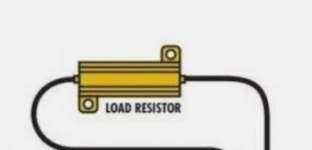You are using an out of date browser. It may not display this or other websites correctly.
You should upgrade or use an alternative browser.
You should upgrade or use an alternative browser.
Led rear lights
- Thread starter Sonar
- Start date
Pudsey Bear
Full Member
- Messages
- 15,082
5ohm resister works.
Sonar
Free Member
- Messages
- 784
It’s a cluster.5ohm resister works.
Where would I get some and how to fit them please.
One of the lights have been smashed in by a hit and run driver
Never stopped it was in a car park..
however I have two led lights fitted one yesterday and the lights flashing was to fast.
Seems it went into super fast mode as it detected a broken bulb. Well it’s not there now…
If I could get a small 12 bulb and lens I could fit that and I am sure the problem would be sorted .
As led lights use less power I need to increase the draw to 12 volts a resister seems again the only way.
But can’t say what power is being drawn with the led indecators.

Last edited:
Sonar
Free Member
- Messages
- 784
Full light cluster. It’s just the indecators that flash very fastLights or just bulbs ?
Sonar
Free Member
- Messages
- 784
Could it be these.5ohm resister works.

4 X 12v Led Load In-Line Resistors 50w 6 Ohm For Led Rear Tail Lights Indicators | eBay UK
4 x 50W 6OHM LED Load Resistors. Rate of Work: 50W. 4 X 12v Led Load In-Line Resistors. Resistance: 6 OHM. Material: Aluminium shell. Width: 22 mm / 0.87". Height: 16 mm / 0.63".
www.ebay.co.uk
RoaminRog
Full Member
- Messages
- 2,411
On my Autotrail I use these cluster lights They have a 12v bulb in the middle and therefore everything works fine.
Can’t believe the price nowadays!
Exwindsurfer
Full Member
- Messages
- 4,382
Ouch Rog lolol
On my Autotrail I use these cluster lights They have a 12v bulb in the middle and therefore everything works fine.
Can’t believe the price nowadays!
Sonar
Free Member
- Messages
- 784
That gets over the problem.
On my Autotrail I use these cluster lights They have a 12v bulb in the middle and therefore everything works fine.
Can’t believe the price nowadays!
However a bit pricy.
I had two pairs of these given to me at the start of the year
They were going to be for a boat trailer but were not able to be immersed in water.
Attachments
Pudsey Bear
Full Member
- Messages
- 15,082
Not done it for a long time I recall just in the 12v feed wire.It’s a cluster.
Where would I get some and how to fit them please.
One of the lights have been smashed in by a hit and run driver
Never stopped it was in a car park..
however I have two led lights fitted one yesterday and the lights flashing was to fast.
Seems it went into super fast mode as it detected a broken bulb. Well it’s not there now…
If I could get a small 12 bulb and lens I could fit that and I am sure the problem would be sorted .
As led lights use less power I need to increase the draw to 12 volts a resister seems again the only way.
But can’t say what power is being drawn with the led indecators.
View attachment 74161
merl
Full Member
- Messages
- 320
Kev's idea of adding a dummy load resistor would be the cheapest option. You'll need to connect the resistor between ground and the indicator feed. Personally I'd open up the cluster, trace the tracks and solder it inside there but you could fit it externally on the cable coming in.
5 ohms is the nearest preferred value but will dissipate nearly 30 watts while it's on therefore about 15watts overall so will get quite hot especially if/when you sit with the indicator on for a time. A 7.5 ohm would be better and I reckon a 10 ohm would still fool the system. 10 ohms would mean 15watts/7watts overall, a lot cooler, smaller and cheaper. Search on eBay and make sure you don't go lower with the wattage, going higher is ok. You could always just use a bulb of course .
.
5 ohms is the nearest preferred value but will dissipate nearly 30 watts while it's on therefore about 15watts overall so will get quite hot especially if/when you sit with the indicator on for a time. A 7.5 ohm would be better and I reckon a 10 ohm would still fool the system. 10 ohms would mean 15watts/7watts overall, a lot cooler, smaller and cheaper. Search on eBay and make sure you don't go lower with the wattage, going higher is ok. You could always just use a bulb of course
Pudsey Bear
Full Member
- Messages
- 15,082
Wish I was clever like wot you am Merlin.
Tbf it was a long time ago, and I took advice from forum member on SBMCC, never a good idea.
Tbf it was a long time ago, and I took advice from forum member on SBMCC, never a good idea.
Sonar
Free Member
- Messages
- 784
The total cost of 4 load resisters is under £6.
They can be fixed away from the wiring so hope there not get too hot I have some metal bumper brackets there fix ok the them and the metal
Should also work to act as a heat sink..
Remove the bulbs and solder in place that was my very first thoughts some sort of orange cover over them so the light shows underneath.
But. Decided just to go with the load resistors ..

They can be fixed away from the wiring so hope there not get too hot I have some metal bumper brackets there fix ok the them and the metal
Should also work to act as a heat sink..
Remove the bulbs and solder in place that was my very first thoughts some sort of orange cover over them so the light shows underneath.
But. Decided just to go with the load resistors ..

Sonar
Free Member
- Messages
- 784
That explains why the wire is heat resistant then…on the load resistors.Kev's idea of adding a dummy load resistor would be the cheapest option. You'll need to connect the resistor between ground and the indicator feed. Personally I'd open up the cluster, trace the tracks and solder it inside there but you could fit it externally on the cable coming in.
5 ohms is the nearest preferred value but will dissipate nearly 30 watts while it's on therefore about 15watts overall so will get quite hot especially if/when you sit with the indicator on for a time. A 7.5 ohm would be better and I reckon a 10 ohm would still fool the system. 10 ohms would mean 15watts/7watts overall, a lot cooler, smaller and cheaper. Search on eBay and make sure you don't go lower with the wattage, going higher is ok. You could always just use a bulb of course.
Pudsey Bear
Full Member
- Messages
- 15,082
merl
Full Member
- Messages
- 320
Yep, that sort of design you can screw down to metal to act be as a heatsink. Most are like that when you go over 5/10 watts. I've got a 8 ohm 200w that I use as a dummy speaker load when testing amps, you can't bolt it to a heatsink but it's the size of a 1/2 pound bar of chocolate!


